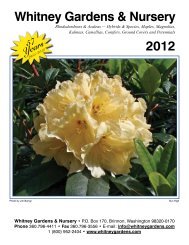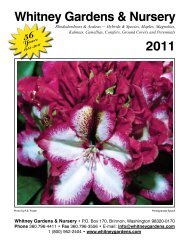Download the Catalog! - Whitney Gardens & Nursery
Download the Catalog! - Whitney Gardens & Nursery
Download the Catalog! - Whitney Gardens & Nursery
You also want an ePaper? Increase the reach of your titles
YUMPU automatically turns print PDFs into web optimized ePapers that Google loves.
during daylight hours in moist and shady spots. On sunny days <strong>the</strong>y<br />
can be found in leaf and weed litter beneath <strong>the</strong> plant. On cloudy/<br />
rainy days, <strong>the</strong>y may be found on <strong>the</strong> plant itself. Spray early in <strong>the</strong><br />
morning or late in <strong>the</strong> day, to minimize <strong>the</strong> affect on <strong>the</strong> birds<br />
and bees.Foliar insecticides registered for controlling black vine<br />
weevil and strawberry root weevil, include Or<strong>the</strong>ne, Talstar (liquid &<br />
granular), and Mavrik. The last two have a longer residual property<br />
and hence greater control.<br />
Biological & Ecological Controls - Increased interest is developing<br />
for controlling insects with materials from nature. Lady bugs, as an<br />
example, prey upon aphids, mites and scale; spiders prey upon flying<br />
insects; and <strong>the</strong> ground beetle (Vedalia Lady) preys upon aphids,<br />
scale, mealy buds and caterpillars. Toads, snakes and birds prey upon<br />
many garden pests. There are also natural chemicals such as nicotine<br />
from tobacco, pyrethrum from chrysan<strong>the</strong>mums and Dimboa from<br />
corn. Researchers are working on microorganisms that feed on<br />
insects. A commercial insect called nematodes (Steinernema<br />
Carpocapsae) is a tool for some control of weevil larvae, as long as<br />
soil temperatures remain about 60°F., plus an application of water.<br />
This fall application must be repeated yearly.<br />
Organic Controls - There are several o<strong>the</strong>r measures that can be<br />
used to reduce <strong>the</strong> weevil population without sprays. Tangle-foot,<br />
Stik-Em or Tack Trap can be applied to <strong>the</strong> trunk of <strong>the</strong> plant just<br />
above <strong>the</strong> ground level. The sticky band acts as a barrier and entrapment.<br />
Make a pitfall trap by placing a sizable plastic drinking cup into <strong>the</strong><br />
soil near <strong>the</strong> base of <strong>the</strong> plant so that <strong>the</strong> lip of <strong>the</strong> cup is at soil level.<br />
Coat <strong>the</strong> inside of this cup with 30W motor oil or WD 40 to discourage<br />
<strong>the</strong> adult weevil from climbing out. To keep rainfall and/or irrigation<br />
water out of this cup, invert a coffee can or plastic pot over <strong>the</strong><br />
pitfall traps, making legs, etc. Check daily and destroy weevils.<br />
Fold a burlap bag into 4” accordion folds, holding one end against<br />
<strong>the</strong> plant and rotating <strong>the</strong> burlap around <strong>the</strong> stem, creating a good<br />
daytime environment for <strong>the</strong> adult weevil. After a day or two, cautiously<br />
unwind <strong>the</strong> burlap from beneath <strong>the</strong> plant and shake over a<br />
white sheet or clear surface. Collect and destroy <strong>the</strong> weevil. Repeat.<br />
Cultural Control - Many varieties of rhododendrons and azaleas<br />
demonstrate considerable weevil resistance. Selecting resistant varieties<br />
will reduce required maintenance and damage.<br />
O<strong>the</strong>r Chemical Controls - Some of <strong>the</strong> minor pests to <strong>the</strong> genus<br />
rhododendron are aphid, loopers, cutworms, caterpillars, azalea leaf<br />
miners, rhododendron lacebugs, and whitefly, which can all be controlled<br />
by <strong>the</strong> use of insecticides. Along with <strong>the</strong> chemical formulation,<br />
use 1T. per gallon of a sticker or liquid detergent. This helps<br />
to retain <strong>the</strong> chemical on <strong>the</strong> leaf longer.<br />
Control for Slugs - Slugs and snails are usually controlled with slug<br />
bait - metaldehyde formulated with cereal grains and molasses<br />
placed under raised boards. Ano<strong>the</strong>r method is to use wooden planks.<br />
The slug attaches to <strong>the</strong> underside of <strong>the</strong> plank and by turning over<br />
<strong>the</strong> plank, removal is possible. Placing beer or yeast in a shallow<br />
container attracts slugs and <strong>the</strong>y drown in <strong>the</strong> container. Ducks,<br />
snakes and toads will prey upon slugs as natural predators.<br />
Control for Moles - In <strong>the</strong> Pacific Northwest; <strong>the</strong>re are several mole<br />
traps that are recommended. Poison baits should be odorless and<br />
tasteless. Baits containing chlorophacinone have been effective,<br />
although more than a single feeding may be necessary to do <strong>the</strong> job.<br />
Traps and poison bait must be placed carefully in a main underground<br />
tunnel, which is usually 6”-10” below <strong>the</strong> surface. The o<strong>the</strong>r<br />
remedy is to destroy <strong>the</strong> food chain of <strong>the</strong> mole.<br />
Control for Deer - Deer do not like rhododendrons, but love to eat<br />
azaleas, dogwood blooms, new growth on evergreen trees and<br />
shrubs. A product called ‘Hinder’ is 80% effective, as long as you<br />
continue to spray. The uses of certain hand soaps, human hair, blood<br />
meal, etc. all have questionable effectiveness.<br />
Control for Algae, Lichen and Moss on Plants - The cool, moist<br />
and cloudy wea<strong>the</strong>r in western Washington is ideal for <strong>the</strong>se organisms.<br />
They do not directly injure <strong>the</strong> plants on which <strong>the</strong>y grow. The<br />
growth is somewhat objectionable and unsightly. Control with copper<br />
fungicides such as Microcop or lime sulfur. Best applied during<br />
<strong>the</strong> dormant season. Remember, that birds use much of this material<br />
to build <strong>the</strong>ir nests. Next time, look at a Hummingbirds’ nest.<br />
Control of Powdery Mildew - Leaves are covered with a grayish/<br />
white powdery fungus growth. It usually affects plants located in<br />
more shade. At <strong>the</strong> first sign of <strong>the</strong> fungus, spray with a registered<br />
fungicide as Bayleton, Benomyl; also rake up and destroy all fallen<br />
leaves.<br />
Control for Rust - To date no fungicides are registered for control<br />
of this disease. The symptoms are light green to yellow spots randomly<br />
distributed on <strong>the</strong> leaf. Yellow to orange powdery spores on<br />
<strong>the</strong> underside of <strong>the</strong> leaf are also associated.<br />
Caring for Rhododendrons - Rhododendrons should be pruned to<br />
reduce <strong>the</strong>ir stature, to rejuvenate <strong>the</strong>m, to make <strong>the</strong>m more compact<br />
and to cut away diseased or injured branches. There are two ways of<br />
controlling <strong>the</strong> shape, density and size of a rhododendron - pruning<br />
and pinching (removing growth buds).<br />
Pruning - Rhododendrons can be cut back early in <strong>the</strong> spring. By<br />
using pruning shears and/or saws, cut at an angle just above <strong>the</strong> termination<br />
of a growth period. If, however, you want to save <strong>the</strong><br />
bloom, prune after blooming. Big old limbs should be cut at random<br />
and <strong>the</strong>n after <strong>the</strong> side shoots have appeared, <strong>the</strong> stub above that<br />
point can be removed.<br />
Pinching (Removing Growth Buds) - Pinching is <strong>the</strong> removal of a<br />
single growth bud at <strong>the</strong> tip of a branch. Any branch tip that shows<br />
two or more developing shoots is passed by. Pinching can be done in<br />
<strong>the</strong> fall; however, if done about blooming time, pinch when growth<br />
is less than 1” long. Pinching encourages increased foliage density,<br />
compact growth habit and a greater floral display for <strong>the</strong> coming<br />
years.<br />
Deheading (Removing Faded Flowers) - The best practice is to<br />
remove by carefully snapping or cutting off all faded trusses soon<br />
after <strong>the</strong> flower wilts. Some plants produce a greater abundance<br />
ofseed, so deheading has a greater importance. Deheading gives <strong>the</strong><br />
plant an immediate well-groomed look and reduces <strong>the</strong> problem of<br />
disease as <strong>the</strong> faded blooms decay, and hopefully, encourages blooms<br />
for <strong>the</strong> next year.<br />
Winter Protection - The aim is to give a plant a ventilated enclosure<br />
in which temperature fluctuations are more moderate. 1) Wooden<br />
frame covered with burlap leaving <strong>the</strong> top open. 2) O<strong>the</strong>r plants or<br />
trees, lath barriers or fencing. 3) Evergreen trees branches thrust into<br />
<strong>the</strong> ground at an angle. 4) A wooden teepee covered with burlap,<br />
allowing a vented space on top for snow protection. 5) Leaf mulch<br />
added to <strong>the</strong> base of <strong>the</strong> plant in <strong>the</strong> fall (not to cover foliage, and<br />
removed in spring) keeps <strong>the</strong> trunk from splitting and <strong>the</strong> earth from<br />
freezing deeply.<br />
Why plants fail to bloom - It is usually difficult to determine <strong>the</strong><br />
exact cause a particular plant fails to bloom, but in most cases <strong>the</strong><br />
problem is attributed to environmental factors. 1) There is a direct<br />
correlation between adequate light and bloom. Too much shade<br />
decreases <strong>the</strong> bud set. 2) Competition for moisture and nutrients by<br />
adjacent trees and shrubs also reduces and discourages blooms. 3) If<br />
you plant your shrub too deep or in a wet area, it reduces <strong>the</strong> amount<br />
of oxygen to <strong>the</strong> roots and again bud set is compromised as well as<br />
<strong>the</strong> health of <strong>the</strong> plant. 4) Pruning at <strong>the</strong> wrong time of <strong>the</strong> year. 5)<br />
Too much nitrogen encourages vegetative growth at <strong>the</strong> expense of<br />
bud development.<br />
Hardiness - A newly planted shrub is hardier after <strong>the</strong> first year, as<br />
it establishes itself in its new, healthy and enriched environment. A<br />
plant is considered totally matured for hardiness at five years of<br />
age. There are many aspects, which play an important role in hardiness,<br />
as <strong>the</strong> amount of water and fertilizer, and when applied; also <strong>the</strong><br />
exposure to wind, sun and freeze and <strong>the</strong> duration <strong>the</strong>reof, and <strong>the</strong><br />
amount of snow cover and mulch on <strong>the</strong> roots, etc. In general, <strong>the</strong><br />
degree of dormancy, <strong>the</strong> age, <strong>the</strong> health, <strong>the</strong> exposure and <strong>the</strong><br />
environment provide <strong>the</strong> total answer to plant hardiness.<br />
Website: www.whitneygardens.com. • Brinnon, WA 98320 • Ph: (800) 952-2404 • Fx: (360) 796-3556<br />
Email: info@whitneygardens.com 85





